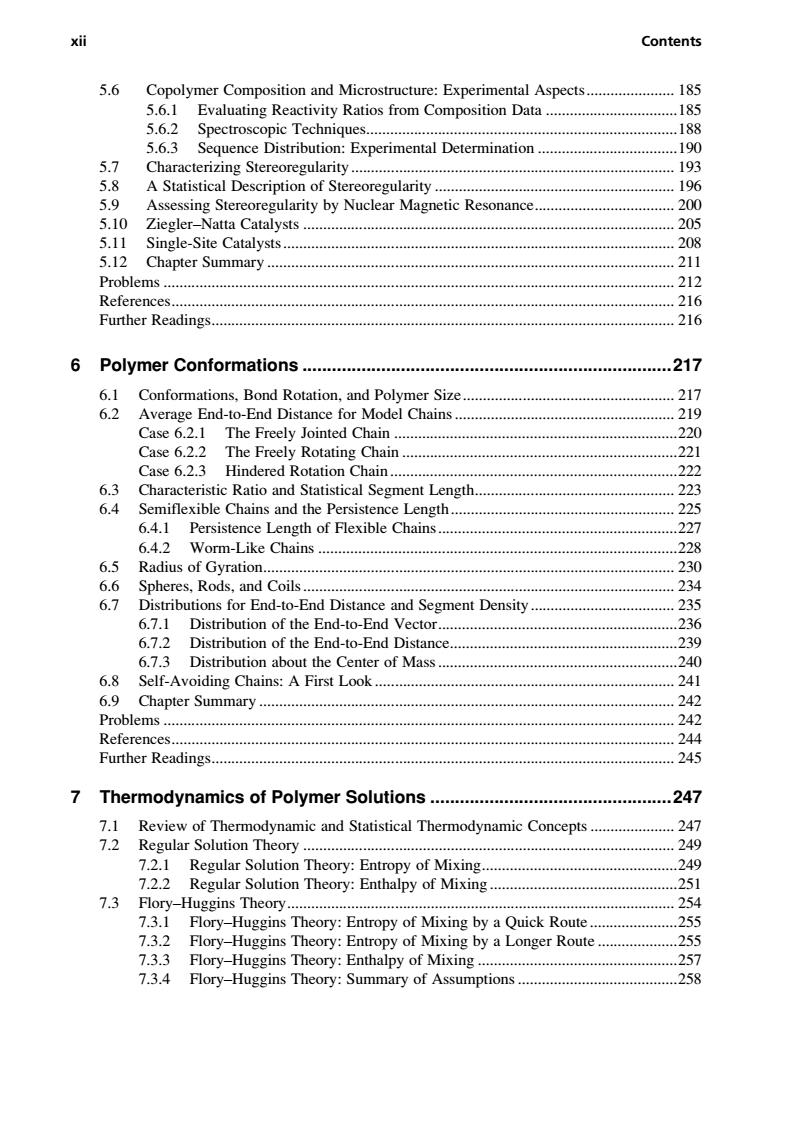正在加载图片...

xii Contents 5.6 Copolymer Composition and Microstructure:Experimental Aspects.185 5.6.1 Evaluating Reactivity Ratios from Composition Data..........................185 5.6.2 Spectroscopic Techniques.....188 5.6.3 Sequence Distribution:Experimental Determination.......190 5.7 Characterizing Stereoregularity193 5.8 A Statistical Description of Stereoregularity......................96 5.9 Assessing Stereoregularity by Nuclear Magnetic Resonance. 44444444444444444 200 5.10 Ziegler-Natta Catalysts.. 444444444444444444 205 5.11 Single-Site Catalysts............. 208 5.12 Chapter Summary… 211 Problems........ 212 References..... 216 Further Readings......... 216 6 Polymer Conformations................... 217 6.1 Conformations,Bond Rotation,and Polymer Size.... .217 6.2 Average End-to-End Distance for Model Chains... 219 Case 6.2.1 The Freely Jointed Chain.................... 220 Case 6.2.2 The Freely Rotating Chain........... 221 Case 6.2.3 Hindered Rotation Chain......... .222 6.3 Characteristic Ratio and Statistical Segment Length 223 6.4 Semiflexible Chains and the Persistence Length..... 225 6.4.1 Persistence Length of Flexible Chains..... .227 6.4.2 Worm-Like Chains.... .228 6.5 Radius of Gyration. 230 6.6 Spheres,Rods,and Coils. 234 6.7 Distributions for End-to-End Distance and Segment Density..............235 6.7.1 Distribution of the End-to-End Vector..236 6.7.2 Distribution of the End-to-End Distance..239 6.7.3 Distribution about the Center of Mass.240 6.8 Self-Avoiding Chains:AFirst Look.241 6.9 Chapter Summary 242 Problems… 242 References...... 244 Further Readings.… 245 7 Thermodynamics of Polymer Solutions................... .247 7.1 Review of Thermodynamic and Statistical Thermodynamic Concepts 247 7.2 Regular Solution Theory. 249 7.2.1 Regular Solution Theory:Entropy of Mixing....249 7.2.2 Regular Solution Theory:Enthalpy of Mixing......................................5.1 7.3 Flory-Huggins Theory254 7.3.1 Flory-Huggins Theory:Entropy of Mixing by a Quick Route....................2.55 7.3.2 Flory-Huggins Theory:Entropy of Mixing by a Longer Route...55 7.3.3 Flory-Huggins Theory:Enthalpy of Mixing....................................257 7.3.4 Flory-Huggins Theory:Summary of Assumptions...............2585.6 Copolymer Composition and Microstructure: Experimental Aspects...................... 185 5.6.1 Evaluating Reactivity Ratios from Composition Data .................................185 5.6.2 Spectroscopic Techniques..............................................................................188 5.6.3 Sequence Distribution: Experimental Determination ...................................190 5.7 Characterizing Stereoregularity................................................................................. 193 5.8 A Statistical Description of Stereoregularity ............................................................ 196 5.9 Assessing Stereoregularity by Nuclear Magnetic Resonance................................... 200 5.10 Ziegler–Natta Catalysts ............................................................................................. 205 5.11 Single-Site Catalysts .................................................................................................. 208 5.12 Chapter Summary ...................................................................................................... 211 Problems ................................................................................................................................ 212 References.............................................................................................................................. 216 Further Readings.................................................................................................................... 216 6 Polymer Conformations ...........................................................................217 6.1 Conformations, Bond Rotation, and Polymer Size..................................................... 217 6.2 Average End-to-End Distance for Model Chains ....................................................... 219 Case 6.2.1 The Freely Jointed Chain .......................................................................220 Case 6.2.2 The Freely Rotating Chain .....................................................................221 Case 6.2.3 Hindered Rotation Chain ........................................................................222 6.3 Characteristic Ratio and Statistical Segment Length.................................................. 223 6.4 Semiflexible Chains and the Persistence Length........................................................ 225 6.4.1 Persistence Length of Flexible Chains............................................................227 6.4.2 Worm-Like Chains ..........................................................................................228 6.5 Radius of Gyration....................................................................................................... 230 6.6 Spheres, Rods, and Coils ............................................................................................. 234 6.7 Distributions for End-to-End Distance and Segment Density.................................... 235 6.7.1 Distribution of the End-to-End Vector............................................................236 6.7.2 Distribution of the End-to-End Distance.........................................................239 6.7.3 Distribution about the Center of Mass ............................................................240 6.8 Self-Avoiding Chains: A First Look ........................................................................... 241 6.9 Chapter Summary ........................................................................................................ 242 Problems ................................................................................................................................ 242 References.............................................................................................................................. 244 Further Readings.................................................................................................................... 245 7 Thermodynamics of Polymer Solutions .................................................247 7.1 Review of Thermodynamic and Statistical Thermodynamic Concepts ..................... 247 7.2 Regular Solution Theory ............................................................................................. 249 7.2.1 Regular Solution Theory: Entropy of Mixing.................................................249 7.2.2 Regular Solution Theory: Enthalpy of Mixing ...............................................251 7.3 Flory–Huggins Theory................................................................................................. 254 7.3.1 Flory–Huggins Theory: Entropy of Mixing by a Quick Route ......................255 7.3.2 Flory–Huggins Theory: Entropy of Mixing by a Longer Route ....................255 7.3.3 Flory–Huggins Theory: Enthalpy of Mixing ..................................................257 7.3.4 Flory–Huggins Theory: Summary of Assumptions ........................................258 Hiemenz/ Polymer Chemistry, 2nd Edition DK4670_C000 Final Proof page xii 5.11.2007 8:20pm Compositor Name: JGanesan xii Contents